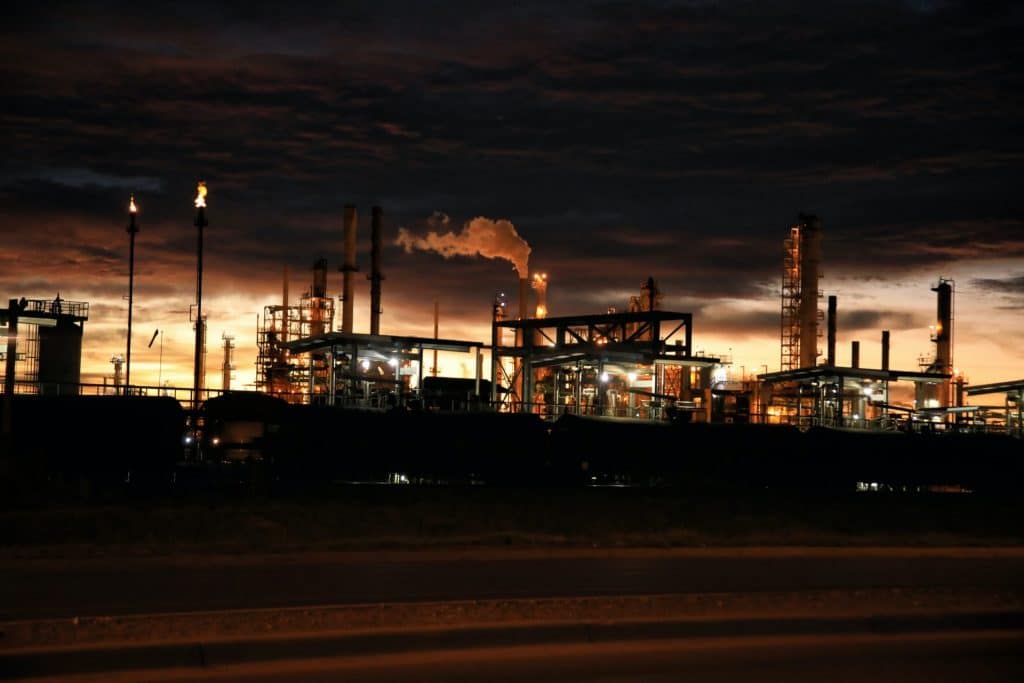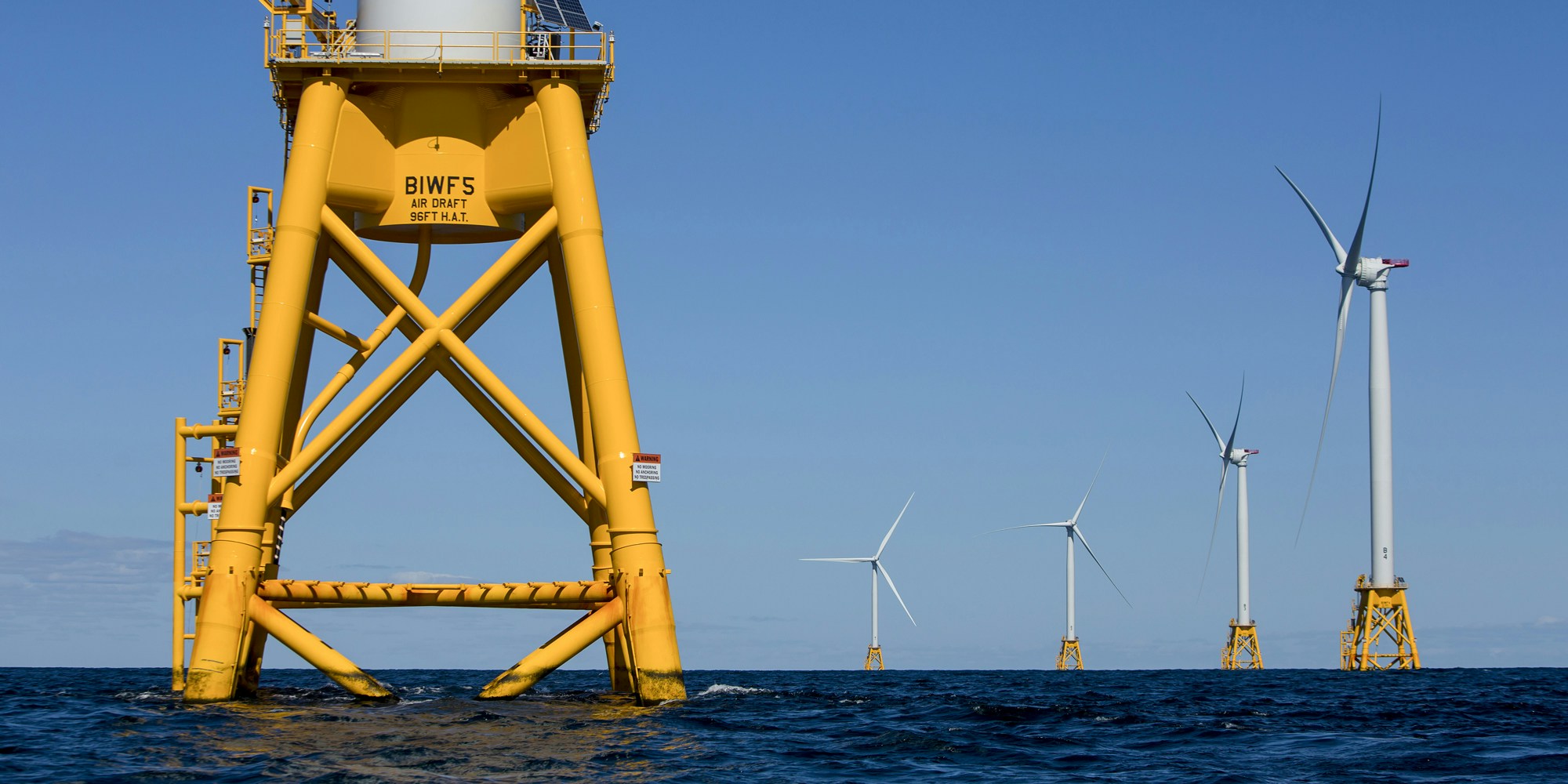
Supported by
.png)
Leanna First-Arai
Thu 16 Dec 2021
In January of 2019, Chase Lochmiller and Cully Cavness, recently reunited prep school pals from Denver, drove out to the snow-covered plains of Wyoming to bring a piece of tech culture to the American heartland. Trembling in -20F (-29C) temperatures, they wired up a prototype of their brainchild: a machine that harnesses the “waste gas” from oil rigs to power mining for cryptocurrency.
Cryptocurrencies such as bitcoin, the most-popular decentralized digital currency, have a notoriously large carbon footprint (bitcoin mining alone consumes about half as much electricity in a year as all of the UK). So to leverage a cheap source of energy to run their bitcoin mining operations, Lochmiller and Cavness found themselves partnering with oil companies to repurpose a byproduct, primarily methane, that’s typically vented or burnt off in flares.

Waste from one bitcoin transaction ‘like binning two iPhones’
“We flipped the switch and saw all the bitcoin mining servers light up green, and you could see the flare physically shrink a little bit,” said Lochmiller, a self-described “city kid” who had never before set foot in an oilfield.
“It was kind of a Frankenstein moment, like ‘Oh my god, it’s alive!’”
Their creation is part of a niche wave of tech startups that are now eyeing the oil and gas industry to help power the cryptocurrency boom. Lochmiller and Cavness, who started a bitcoin mining company called Crusoe Energy, see their fix as a marriage between two problems capable of “solving” one another: the wasting of gas flaring that contributes to the climate crisis, and the need for cheaper energy as crypto increases in popularity.

Climate experts, however, warn it’s a “false solution” so long as oil and gas production is allowed to continue. The world’s leading authority on climate science concludes that only a dramatic reduction in greenhouse gas emissions will help avert a climate calamity; merely finding alternate uses for “waste gas” doesn’t confront the dire need to curb fossil fuel consumption. If anything, researchers warn, oil companies may feel incentivized to drill even more.
“At the end of the day, they’re still burning natural gas,” said Arvind Ravikumar, a methane researcher at the University of Texas at Austin, who deemed flare mitigation and companies proposing similar technologies a “scam”.
Lochmiller and Cavness, however, say their work helps the industry produce oil in as clean a way as possible, buying time, or “extending the runway” for the energy transition.
Their company has attracted high-profile investors, including Bain and Winklevoss Capital, raking in $125m for their second round of fundraising in April. They plan to roll out 100 bitcoin mining data centers by early 2022, up from the 65 units already in place.
Crusoe has trademarked its solution as “digital flare mitigation”. They install fleets of data centers that hum in shipping container-like structures next to remote oil rigs. Oil producers are then paid for the waste gas they otherwise wouldn’t use because it’s cheaper to burn than to pay to transport to market. In return, Crusoe can use the byproduct to power energy-intensive computing operations on-site.

The data centers burn through enormous amounts of energy because there’s no centralized “bank” that holds cryptocurrency. Instead, new coins are created by solving complex equations that require heavy computing power to authenticate. The currency is then tracked on a decentralized ledger, known as the blockchain, which is also resource-intensive to maintain.
The new technology comes amid a “great mining migration” that’s currently underway in the United States after China banned crypto mining in September. And with renewed global focus on cutting the highly-potent greenhouse gas, methane, which is the primary “waste gas” in flaring, the model is particularly in vogue.
Oil-friendly regulators, elected officials, industry groups and financial services giants have been taking note. Commissioner Jim Wright of the Texas Railroad Commission, the state agency charged with regulating oil and gas, told the Guardian that modular mitigation setups like Crusoe’s are “most appealing”. Texas senator Ted Cruz is also a fan.
Meanwhile, North Dakota lawmakers on both sides of the aisle passed a law this year making oil producers eligible for a tax credit if they employ onsite flare mitigation. Crusoe, which is based in Williston, North Dakota – the heart of the Bakken shale – worked closely with legislators to pass the bill.
According to Paasha Mahdavi, a political science professor at the University of California, Santa Barbara, who co-authored a 2020 paper on methane mitigation measures, new technologies that stop flaring at the source do seem like they would reduce emissions.
But in practice, he said, projects designed to capture otherwise flared or vented gas have resulted in an overall increase in gas production. After all, they create a new source of demand.
“It’s like if you had a leaky gasoline pipeline and, instead of fixing the problem, you plugged in a Humvee next to the leak and left the engine on in perpetuity with the A/C on full blast,” Mahdavi said.
Cavness, the chief executive of Crusoe Energy who goes by “Electron Cowboy” on Twitter, grew up envisioning himself jumping on the family bandwagon. He would get an internship with Shell, and follow in the footsteps of his father and grandfather to carve out a career in the oil and gas industry.
But then Cavness landed at Middlebury College, a prestigious liberal arts school in Vermont with a reputation as the alma mater of global climate campaign, 350.org founders, and home of the university fossil fuel divestment movement.
“Climate was the whole conversation,” Cavness said, noting that he felt pressure to downplay his oil and gas roots.
After going down the climate rabbit hole at Middlebury, and spending a year after graduation studying the “morality of energy”, Cavness’ job was troubling his conscience. He’d been losing sleep thinking about the unfathomable amount of gas the industry was wasting. According to the International Energy Agency (IEA) in 2020, 142bn cubic metres of gas was flared – the energy equivalent of providing electricity to 49m homes.
When Cavness reunited with Lochmiller in 2018 during an 18-hour hiking trip in the Rocky Mountains, they hatched a plan: Lochmiller, an MIT graduate based in San Francisco, had recently left a position as a partner at a cryptocurrency investment firm, while Cavness was with a separate firm that invested in oil and gas. Together, they would combine their worlds of bitcoin and big oil.

Unsurprisingly, the bitcoin flaring option is enormously appealing to the industry. Crusoe’s data centers are set up without cost to producers, who earn money on gas they otherwise wouldn’t.
“It’s essentially a free offering to the oil company,” Cavness explained earlier this year at Hart Energy’s Developing Unconventional Gas virtual conference for the Bakken and Rockies regions.
Cavness and Lochmiller say they’re on the cusp of the latest climate research. But critics warn their company sits squarely within the techno-optimistic ecosystem of Silicon Valley, where the hunt for innovative solutions may blind even the most climate-literate entrepreneurs.
Climate experts warn Crusoe’s outlook, and it’s proposed “fix”, reflects a selective understanding of the science. Even the most conservative forecasts say oil and gas exploration must stop immediately to prevent the worst impacts of the climate crisis, including unnecessary loss of human lives. But despite Crusoe’s climate-focused branding, Lochmiller confirmed the company supports ongoing exploration and drilling.
As Cavness sees it, even after his now-infant daughter grows old or reaches the end of her life, fossil fuels will still be around. If the oil industry will be “required to sustain life on the planet” anyway, Cavness asks, why not drill in the cleanest way possible?
While the Crusoe chiefs say their digital flare migration technology is buying time for new clean energy sources, some fear their strategy is more like placing a Band-Aid over a gaping wound. Nine out of ten climate experts who responded to requests for comment, including top methane researchers, political scientists, and climate analysts, said that oil and gas exploration and new drilling – even if equipped with methane mitigation technologies – is not in line with a future in which warming is curbed in accordance with global climate pledges.
Of this group, the one dissenting voice, an academic and co-founder of a greenhouse gas monitoring company, said continued exploration and drilling can “probably” happen in a clean way.
It’s like … if you plugged in a Humvee next to the leak and left the engine on in perpetuity with the A/C on full blastPaasha Mahdavi
Climate experts are more split over the degree to which cryptocurrency operations should be allowed to consume renewable energy. Three out of ten climate experts the Guardian spoke with were intrigued by one element of Crusoe’s model.
Similar to waste gas operations, the company has a set of data centers slated to run on wind farms designed to tap energy available when gigawatts generated exceed those demanded. Crusoe’s ability to pay for that energy, according to the company, will enable renewable developers to underwrite new fleets.
But not all are optimistic. Heather Price, an atmospheric chemist and professor at North Seattle College, worries that flare mitigation technology is little more than a greenwashing tactic meant to spin fossil fuels in a positive light.
“I have no faith that this use of flares for crypto would be a temporary situation,” she said. “The fossil fuel industry and crypto companies should not get a ‘cookie’ for this move.”
This story is published as part of Covering Climate Now, a global collaboration of news outlets strengthening coverage of the climate story










